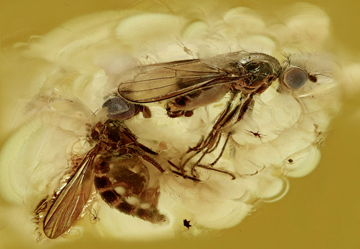Abstract
A new species of Alavesia (Empidoidea: Atelestidae), Alavesia wimpala sp. nov. is described from the mid-Cretaceous amber of Myanmar. Together with the recently described Alavesia longistylata H. Zhang & Wang in Zhang et al. 2020 and A. longicornuta Sinclair & Grimaldi, 2020 the herein described species Alavesia wimpala sp. nov. forms a distinct group of Alavesia Waters & Arillo, 1999 which we consider deserving a subgeneric level. Subgenus Pennonalavesia subgen. nov. is introduced here comprising three species. Males of these species have a very prolonged third segment of stylus bearing a long-oval pennon. The palpus is prolonged and blade- or ribbon-shaped. A catalogue to all 19 species of the genus is given as well as a key to Alavesia (Pennonalavesia subgen. nov.). The function of the prolonged antenna in display and courtship is discussed. Most probably the triangular shape of the wings with its broad base allows a hovering flight in these species to present the pennons at the end of stylus. These characters indicate a high derived courtship behaviour in these flies in the Cretaceous period. On the other hand a possible raptorial behaviour of the new species is suggested.
References
Amorim, D.D.S., Riccardi, P.R. & Rafael, J.A. (2020) First known extant species of Alavesia (Diptera: Atelestidae) in the Neotropical region: Alavesia leukoprosopa, sp. nov., from the southern Atlantic Forest, Brazil. American Museum Novitates, 3962, 12 pp.
https://doi.org/10.1206/3962.1
Barrón, E., Peyrot, D., Rodríguez-López, J.P., Meléndez, N., López del Valle, R., Najarro, M., Rosales, I. & Comas-Rengifo, M.J. (2015) Palynology of Aptian and upper Albian (lower cretaceous) amber-bearing outcrops of the southern margin of the Basque-Cantabrian basin (northern Spain). Cretaceous Research, 52, 292–312.
https://doi.org/10.1016/j.cretres.2014.10.003
Brooks, S. E., Cumming, J. M. & Grimaldi, D. A. (2019) Remarkable new fossil species of Schistostoma Becker (Diptera: Dolichopodidae: Microphoridae) from mid-Cretaceous Burmese amber. Zootaxa, 4624 (1), 121–131.
https://doi.org/10.11646/zootaxa.4624.1.8
Chvála, M. (1983) The Empidoidea (Diptera) of Fennoscandia and Denmark. II. General Part. The families Hybotidae, Atelestidae and Microphoridae. Fauna Entomologica Scandinavica, Scandinavian Science Press, Copenhagen. 12, 279 pp.
Cruickshank, R. D. & Ko, K. (2003) Geology of an amber locality in the Hukawng Valley, Northern Myanmar. Journal of Asian Earth Sciences, 21, 441–455.
https://doi.org/10.1016/S1367-9120(02)00044-5
Cumming, J.M. & Wood, D.M. (2017) [Chapter] 3. Adult morphology and terminology. In: Kirk-Spriggs, A.H. & Sinclair, B.J. (Eds), Manual of Afrotropical Diptera. Volume 1. Introductory chapters and keys to Diptera families. Suricata, 4, South African National Biodiversity Institute, Pretoria, pp. 89–133.
Dollo, L. (1922) Les céphalopodes déroulés et l’irréversibilité de l’évolution. Bijdragen tot de Dierkunde, 12, 215–226.
https://doi.org/10.1163/26660644-02201030
Grichanov, Ya & Brooks, S.E. (2017) [Chapter] 56 Dolichopodidae. In: Kirk-Spriggs, A.H., Sinclair, B.J. (Eds), Manual of Afrotropical Diptera. Volume 2. Nematocerous Diptera and lower Brachycera. Suricata, 5, South African National Biodiversity Institute, Pretoria, pp. 1265–1320.
Grimaldi, D.A., Engel, M.S. & Nascimbene, P.C. (2002) Fossiliferous Cretaceous amber from Myanmar (Burma): its rediscovery, biotic diversity, and paleontological significance. American Museum Novitates, 3361, 1–72.
https://doi.org/10.1206/0003-0082(2002)361<0001:FCAFMB>2.0.CO;2
Jouault, C., Ngo-Muller, V., Zhang, Q.Q. & Nel, A. (2020) New empidoid flies (Diptera: Atelestidae; Dolichopodidae) from mid-Cretaceous Burmese amber. Palaeoentomology, 3 (2), 204–211.
https://doi.org/10.11646/palaeoentomology.3.2.10
Kvaček, J., Barrón, E., Heřmanová, Z., Mendes, M.M., Karch, J., Žemlička, J. & Dudák, J. (2018) Araucarian conifer from late Albian amber of northern Spain. Papers in Palaeontology, 2018, 1–14.
https://doi.org/10.1002/spp2.1223
Peñalver, E. & Arillo, A. (2007) A new species of the family Hybotidae in the Lower Cretaceous amber of El Caleyu (Asturias, Spain); Alavesia prietoi n. sp. Alavesia, 1, 63–68.
Poinar, G.O. & Vega, F.E. (2020) A new genus of Empididae (Diptera) with enlarged postpedicels in mid-Cretaceous Burmese amber. Historical Biology
https://doi.org/10.1080/08912963.2020.1743700
Rodríguez-López, J.P., Peyrot, D. & Barrón, E. (2020) Complex sedimentology and palaeohabitats of Holocene coastal deserts, their topographic controls, and analogues for the mid-Cretaceous of northern Iberia. Earth-Science Reviews, 201, 103075.
https://doi.org/10.1016/j.earscirev.2019.103075
Sinclair, B.J. & Cumming, J.M. (2006) The morphology, higher-level phylogeny and classification of the Empidoidea (Diptera). Zootaxa, 1180 (1), 1–172.
https://doi.org/10.11646/zootaxa.1180.1.1
Sinclair, B.J. & Grimaldi, D.A. (2020) Cretaceous diversity of the relict genus Alavesia Waters and Arillo (Diptera: Empidoidea: Atelestidae). American Museum Novitates, 3961, 40 pp.
https://doi.org/10.1206/3961.1
Sinclair, B.J. & Kirk-Spriggs, A.H. (2009) Brandberg Massif (Namibia) serves up another living fossil! Fly Times, 42, 2–4.
Sinclair, B.J. & Kirk-Spriggs, A.H. (2010) Alavesia Waters and Arillo—a Cretaceous-era genus discovered extant on the Brandberg Massif, Namibia (Diptera: Atelestidae). Systematic Entomology, 35, 268–276.
https://doi.org/10.1111/j.1365-3113.2009.00506.x
Shi, G., Grimaldi, D.A., Harlow, G.E., Wang, J., Wang, J., Yang, M., Lei, W., Li, Q. & Li, X. (2012) Age constraint on Burmese amber based on U-Pb dating of zircons. Cretaceous Research, 37, 155–163.
https://doi.org/10.1016/j.cretres.2012.03.014
Stuckenberg, B.R. (1999) Antennal evolution in the Brachycera (Diptera), with a reassessment of terminology relating to the flagellum. Studia dipterologica, 6, 33–48.
https://doi.org/10.1038/s41598-018-26848-w
Waters, S.B. & Arillo, A. (1999) A new genus of Hybotidae (Diptera, Empidoidea) from Lower Cretaceous amber of Alava (Spain). Studia dipterologica, 6, 59–66.
Willmann, R. (1986) Der Beutefang des Mückenhaftes. Natur und Museum, 116 (8), 245–252.
Xing, L., Stanley, E.L., Bai, M. & Blackburn, D.C. (2018) The earliest direct evidence of frogs in wet tropical forests from Cretaceous Burmese amber. Scientific Reports, 8, 8770.
https://doi.org/10.5962/bhl.part.80273
Yang, D. & Merz, B. (2004) New species of Hybos from Guangxi, China (Diptera, Empidoidea, Hybotidae). Revue Suisse de Zoologie, 111 (4), 877–887.
Zhang, H., Shih, C., Ren, D. & Wang, J. (2020) New Alavesia species from mid-Cretaceous Burmese amber highlight genitalic structural homology (Diptera: Empidoidea: Atelestidae). Cretaceous Research, 116, 104573.
https://doi.org/10.1016/j.cretres.2020.104573
Zhang, S., Xie, S., Zhang, Y., Wang, B., Zhang, P., Zeng, X. & Yang, Y. (2020) A new species of dance fly (Diptera, Empidoidea, Atelestidae) from mid-Cretaceous Burmese amber. Cretaceous Research, 104660.


